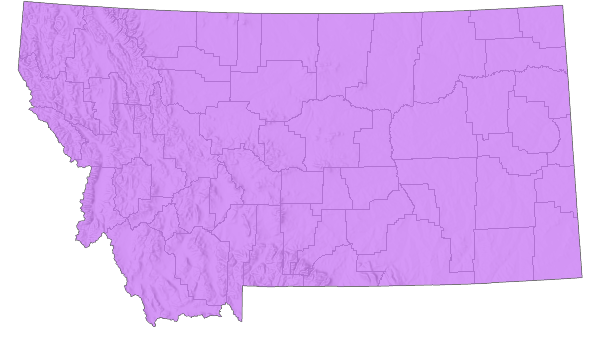View in other NatureServe Network Field Guides
NatureServe
Montana
Utah
Wyoming
Idaho
Wisconsin
British Columbia
South Carolina
Yukon
California
New York
Snakeweed Grasshopper - Hesperotettix viridis
General Description
The following is taken from Capinera et al. (2004), Pfadt (2002), Scott (2010), and Vickery and Kevan (1985). A colorful green, medium-size species with striking markings of black, white or cream, and orange stripes. The dorsal head has a white or cream stripe which extends onto the top of the pronotum. Laterally, a dark stripe behind the eye, extends onto the pronotum and is bordered by white stripes. The fore and mid femurs are green and orange, the hind femur possesses an orange ring near the knee. The hind tibia is light blue, sometimes greenish blue in females.
Phenology
Overwinters in an embryonic stage going into diapause. Nymphs are believed to begin appearing in late June or early July. Adults occur from August to late September into early October (Pfadt 2002).
Diagnostic Characteristics
The adult body length of males is 16-22 mm, females 20-33 mm. The wings are narrow and may reach to the tip of the abdomen, but commonly only extend two-thirds its length. They are opaque, pale green with a pale longitudinal stripe, and become clear at the tip (Capinera et al. 2004, Pfadt 2002, Scott 2010, Vickery and Kevan 1985).
None in Montana for which it could be confused. There are two subspecies in the U.S.: H. viridus pratensis (generally western) and H. viridus brevipennis (generally eastern) (Vickery and Kevan 1985).
Species Range
Montana Range
Range Descriptions

 Native
Native
Range Comments
The following is taken from Capinera et al. (2004), Scott (2010), and Vickery and Kevan (1985). Very widely distributed over almost all the U.S. from the East Coast to just short of the West Coast, and from the southern provinces of western Canada, south into most of Mexico. In the eastern U.S., the species common name is Meadow Purple Striped Grasshopper (subspecies, H. viridus brevipennis). In Montana, it is also widely distributed, with confirmed reports from 37 counties, with 7 non-confirmed surrounded counties. Thus, this species occurs across about 79% of the state.
Observations in Montana Natural Heritage Program Database
Number of Observations: 21
(Click on the following maps and charts to see full sized version)
Map Help and Descriptions
Relative Density

Recency


 (Observations spanning multiple months or years are excluded from time charts)
(Observations spanning multiple months or years are excluded from time charts)
Habitat
Inhabits dry, weedy, and brushy areas, especially where
broom snakeweed (
Gutierrezia sarothrae), is present. The species is common, but not abundant. It can usually be found hidden in a clump of snakeweed, thus, its common name (Capinera et al. 2004, Pfadt 2002, Scott 2010, Vickery et al. 1985).
Food Habits
Feeds on a variety of plants over its extensive range. All host plants are forbs, and most are in the family Asteraceae. Field observations have shown that this grasshopper feeds on a minimum of 34 plant species over its extensive range. Favored species include snakeweed, rabbitbrush, goldenrod, and ragweed. Also known to feed on trace amounts of grasses, flower petals, pollen, fungi, and other arthropods (Pfadt 2002).
Reproductive Characteristics
The following is taken from Capinera and Sechrist (1982), and Pfadt (2002). Adults appear to have a relatively long reproduction period, from fledging to courtship, mating, and first egg-laying (oviposition) which can begin in early summer and last into early October. The female selects a site of bare ground at the base of a host plant, or a clump of shortgrass to lay 8 to 18 eggs in two columns enclosed in a tough-walled pod. The female digs into the soil while sitting erect, holding onto an upright plant stem. The eggs are deposited while sitting with the hind femurs spread at a sharp angle.
References
- Literature Cited AboveLegend:
 View Online Publication
View Online Publication Capinera, J.L. and T.S. Sechrist. 1982. Grasshoppers of Colorado: Identification, Biology, and Management. Fort Collins, CO: Colorado State University Experiment Station, Bulletin 584S. 161 p.
Capinera, J.L. and T.S. Sechrist. 1982. Grasshoppers of Colorado: Identification, Biology, and Management. Fort Collins, CO: Colorado State University Experiment Station, Bulletin 584S. 161 p. Capinera, J.L., R.D. Scott, and T.J. Walker. 2004. Field Guide to Grasshoppers, Katydids, and Crickets of the United States. Ithaca, NY. Cornell University Press.
Capinera, J.L., R.D. Scott, and T.J. Walker. 2004. Field Guide to Grasshoppers, Katydids, and Crickets of the United States. Ithaca, NY. Cornell University Press. Pfadt, R.E. 2002. Field Guide to Common Western Grasshoppers, 3rd edition. Laramie, WY: Wyoming Agricultural Experiment Station, Bulletin 912, modified by S. Schell and S. Schell for electronic publication. Accessed 19 February 2020. http://www.uwyo.edu/entomology/grasshoppers/field-guide/index.html#fieldguidetoc
Pfadt, R.E. 2002. Field Guide to Common Western Grasshoppers, 3rd edition. Laramie, WY: Wyoming Agricultural Experiment Station, Bulletin 912, modified by S. Schell and S. Schell for electronic publication. Accessed 19 February 2020. http://www.uwyo.edu/entomology/grasshoppers/field-guide/index.html#fieldguidetoc Scott, R.D. 2010. Montana Grasshoppers, Katydids, and Crickets A Pictorial Field Guide to the Orthoptera. MagpieMTGraphics, Billings, MT.
Scott, R.D. 2010. Montana Grasshoppers, Katydids, and Crickets A Pictorial Field Guide to the Orthoptera. MagpieMTGraphics, Billings, MT. Vickery, V. R. and D. K. M. Kevan. 1985. The grasshopper, crickets, and related insects of Canada and adjacent regions. Biosystematics Research Institute, Ottawa, Ontario. Publication Number 1777. 918 pp.
Vickery, V. R. and D. K. M. Kevan. 1985. The grasshopper, crickets, and related insects of Canada and adjacent regions. Biosystematics Research Institute, Ottawa, Ontario. Publication Number 1777. 918 pp.
- Additional ReferencesLegend:
 View Online Publication
View Online Publication
Do you know of a citation we're missing? Anderson, N.L. 1951. Field studies on the biology of range grasshoppers of southeastern Montana. M.Sc. Thesis. Bozeman, Montana: Montana State University. 96 p.
Anderson, N.L. 1951. Field studies on the biology of range grasshoppers of southeastern Montana. M.Sc. Thesis. Bozeman, Montana: Montana State University. 96 p. Anderson, N.L. 1962. Grasshopper-vegetation relationships on Montana grasslands. Ph.D Dissertation. Bozeman, Montana: Montana State University. 73 p.
Anderson, N.L. 1962. Grasshopper-vegetation relationships on Montana grasslands. Ph.D Dissertation. Bozeman, Montana: Montana State University. 73 p. Capinera, J.L., C. Scherer and J. Squitier. 2001. Grasshoppers of Florida. Gainesville, FL: University Press of Florida. 176 p.
Capinera, J.L., C. Scherer and J. Squitier. 2001. Grasshoppers of Florida. Gainesville, FL: University Press of Florida. 176 p. Gillespie, R.L.1992. Dynamics of grasshoppers (Orthoptera: Acrididae) at a rangeland-crop interference. Ph.D. Bozeman, MT: Montana State University. 111 p.
Gillespie, R.L.1992. Dynamics of grasshoppers (Orthoptera: Acrididae) at a rangeland-crop interference. Ph.D. Bozeman, MT: Montana State University. 111 p. Hebard, M. 1928. The Orthoptera of Montana. Proceedings of the Academy of Natural Sciences of Philadelphia, Vol. 80:211-306.
Hebard, M. 1928. The Orthoptera of Montana. Proceedings of the Academy of Natural Sciences of Philadelphia, Vol. 80:211-306. Hebard, M. 1932. Notes on Montana Orthoptera. Proceedings of the Academy of Natural Sciences of Philadelphia. V. 84. pp 251-257.
Hebard, M. 1932. Notes on Montana Orthoptera. Proceedings of the Academy of Natural Sciences of Philadelphia. V. 84. pp 251-257. Mussgnug, G.L. 1972. The structure and performance of an adult population of Aulocara elliotti (Thomas) (Orthoptera, Acrididae) near Billings, Montana. M.Sc. Thesis. Bozeman, MT: Montana State University. 97 p.
Mussgnug, G.L. 1972. The structure and performance of an adult population of Aulocara elliotti (Thomas) (Orthoptera, Acrididae) near Billings, Montana. M.Sc. Thesis. Bozeman, MT: Montana State University. 97 p. Skinner, K.F. 1995. Plant and grasshopper community composition: indicators & interactions across three spatial scales. M.Sc. Thesis. Bozeman, MT: Montana State University. 144 p.
Skinner, K.F. 1995. Plant and grasshopper community composition: indicators & interactions across three spatial scales. M.Sc. Thesis. Bozeman, MT: Montana State University. 144 p.
- Web Search Engines for Articles on "Snakeweed Grasshopper"
- Additional Sources of Information Related to "Insects"





